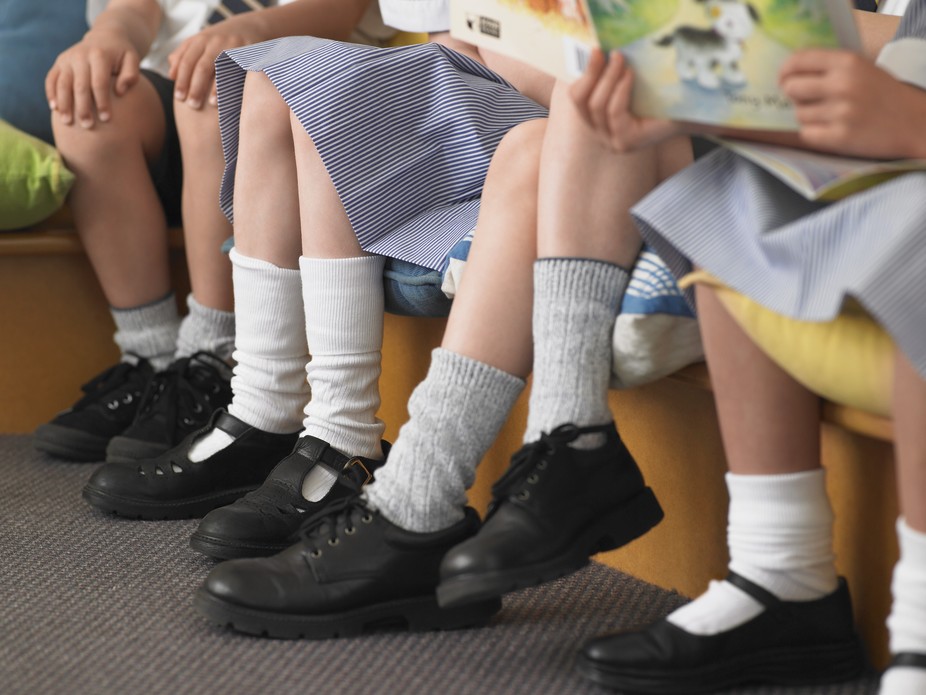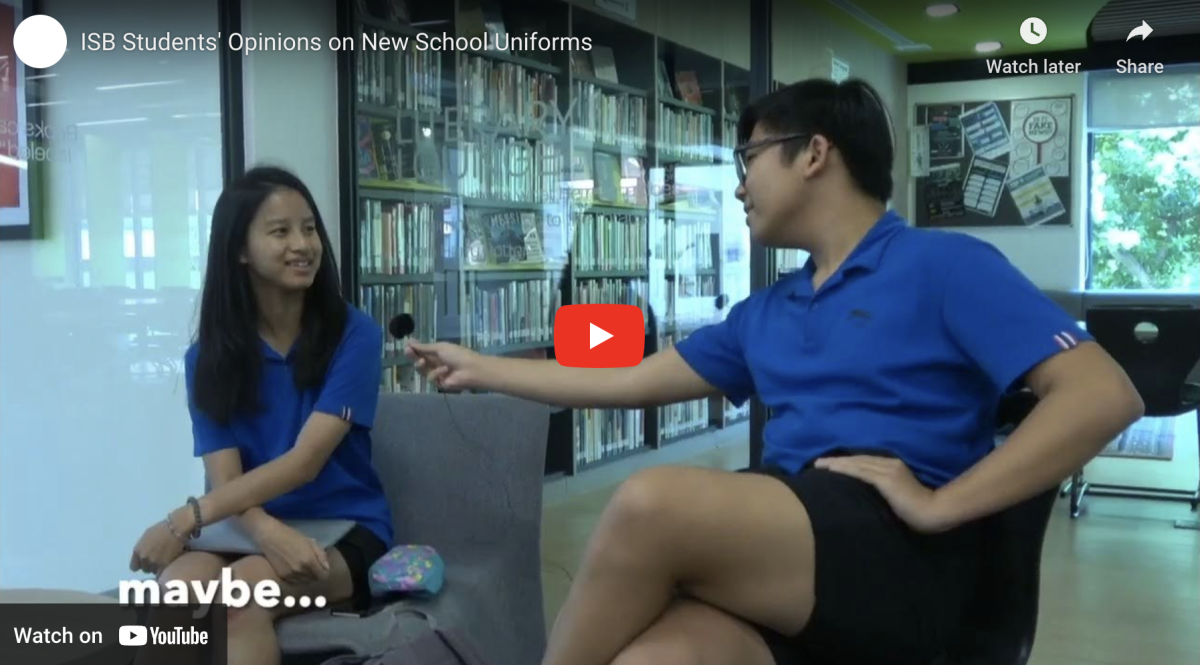Recently, middle school students have had to conduct and write an investigative piece for their English class. PantherNation has decided to highlight some of the articles in order to showcase the writing prowess of ISB’s middle schoolers.
In this piece, Leah Scranton investigates the ISB dress code, in her article The Dress Code Debate.
The Dress Code Debate
For my entire life, I have gone to a school with a uniform. Wearing the same thing every day of my life (except for weekends and vacations) has become a normal thing for me. The same green collared shirt everyday, the same stiff black pants, the same ISB sweaters and jackets. I never really think about uniforms and dress codes besides that fact that I think about putting it on everyday. That is until now. Recently at my school, the International School of Bangkok (ISB), teachers have started enforcing uniform and dress code rules a lot more strictly than they used to. This, of course, got me thinking a lot more about why we have uniforms, but it also leads me to think a lot about the bias and inequality of uniforms. A lot of girls at my school have been talking about how the uniform is sexist because of the certain rules that they think only apply to girls. They have all become really angry at the whole concept. I decided to do some research on this topic, finding sexist dress code scenarios in and out of ISB, and finding more out about the purpose of uniforms and dress codes at ISB.
So, why do we have uniforms?
There have been dress codes in The United States of America since the 1920’s. Today, half of America’s kindergarten through 12th-grade schools use dress codes, according to the National Center For Education Statistics. Dress codes were created to make a safe school environment, to prevent students from being distracted, and to set “appropriate” dress standards in the school community.
However, ISB is not an American school and isn’t even on the same side of the world as the US, so I decided to interview the dean of middle school students at ISB, Mr. Tico Oms, to learn more about our own uniforms. During the interview, the question “why do we have uniforms?” was asked. Mr. Oms explained that the students at this school are here to learn, and clothing shouldn’t exist as a distraction from that. He also talked about how uniforms give a sense of community to our school environment, kind of like how sports teams that have uniforms feel more connected and close because of their jerseys.
To get more information on the uniform itself rather than why we have it, I looked into the middle school student handbook. The dress code rules for ISB’s uniform are as follows:
- All uniforms must be purchased at the ISB Bookstore or made by the ISB-approved tailor.
- You show respect for the school by wearing uniforms that fit properly, are clean and pressed with no holes, tears, frayed areas, or patches.
- School uniforms must be worn as purchased and may not be altered.
- An ISB sweatshirt (purchased at the ISB Bookstore) may be worn over an ISB uniform shirt. No commercial logos or designs are permitted.
- A solid white undershirt or white ISB t-shirt with no commercial logos or designs may be worn under your official ISB uniform polo shirt.
- For your safety, shoes must be worn at all times. Only appropriate and safe footwear with heels lower than 4cm or 1.5 inches are permitted.
- Single plug flip-flops, beach or sport sandals are not permitted. Sandals must have a back strap.
- In case of disagreements of what is acceptable uniform the Principal or Dean makes the final decision.
What is acceptable to wear to school based on the student handbook guidelines?
Are dress codes good for students?
A lot of people would answer the question “are dress codes good for students?” with a firm “no,” while others with a “yes.” Before I get into my own opinion, I would like to give examples of both opinions, pro dress code, and anti-dress code.
Anti-Dress Code (Why we shouldn’t have them):
One of the most common reasons I have heard of why we shouldn’t have dress codes is because they can discriminate against certain groups of people; one of the biggest ones from my experience being girls.
Research done in Canada by Rebecca Raby from Brock University shows that curvier women are told off for their tank tops when less curvy women aren’t. Kayla Touchette, another student in Canada, wore a shirt with the shoulders cut out of the sleeves to school. When she got there, a teacher told her that her shirt was too revealing and that she should cover up. Kayla thought this was unfair because the boys at her school wear basketball jerseys without sleeves to school and no teachers say anything about it. Her teacher even went far enough to say that she should cover her shoulders because it could give boy “ideas.” Several people in her family had something to say about that, including her grandmother, Eleanor Touchette, who thinks that Kayla never leaves the house inappropriately dressed, and that she should not be responsible for what other people think, and said, “Since when is any person responsible for another person’s thoughts or actions?”
Recently, I sent out a survey to one randomly picked class in my grade at ISB. The first question was “Do you agree with/like the ISB dress code?” 81.8% of the people answered no, and many of their explanations to their answers were similar, the most popular ones being along the lines of “I don’t like the rules on length of pants (8 cm above the knee is the shortest,” “it is too strict,” and “it is uncomfortable.” The second question was “Do you think the dress code is sexist or unfairly targets girls?” 72.7% of the class answered with a yes. “All of the guidelines are directed to girls,” “The boys don’t really get dress coded with the shorts lengths for example,” and “teachers only check girl’s pants length” are three explanations that occurred most often. From these answers, it is easy to tell that the majority of the students (based on the sample from one class) at ISB either don’t like the uniform and/or think it is sexist or unfair.
One of the questions on the survey that had the biggest impact on me was “If you identify as a male, does a girl’s shoulders or pant length affect or distract you at all (referring to the dress code rules of pant length and how you are not allowed to show your shoulders)?” 100% of the people who answered this question, answered no. This shows that teachers telling us (females) that our shoulders or legs should be covered because it could give boys “ideas” is not true, and should not be used by teachers when explaining why we have a dress code, or why someone is being dress coded.
Survey Results:
Pro-Dress Code (Why we should have them):
A dress code can be anything between a strict uniform to a general guideline, but either way, they are essential to a school’s culture. Dress codes provide a sense of professionalism, identity, and community. What you wear tells about what you represent. Therefore a school uniform represents a school and what they believe in or value, making it important for schools to have professional or strict dress codes and uniforms.
A strict dress code gives a serious mood to a school, aiding in academics from lack of distraction, and focusing the students more on their success in school than success in popularity based on their clothes. A loose dress code, one that simply bans inappropriate sayings, is made for the same reason – to eliminate distractions – however, does not always give a very serious effect to the school. The strictest form of a dress code, a uniform, is to equalize students, give the students a sense of community, and to eliminate distractions and set a serious mood to the school.
A quote from ISB’s middle school student handbook shows why uniforms are beneficial to school communities, and why they are used here at ISB. “Our school uniform helps create a comfortable and focused learning environment and identifies you as part of the Middle School team. It is a reflection of the seriousness of purpose for your academic experience. Our uniform is intended to minimize distraction so that you can be comfortable, and focused on your learning.”
Personal experiences with dress coding at ISB
At ISB, there is a uniform, but there are also rules that go along with that uniform. For example, students can only wear sweaters or jackets that are from ISB. There are a couple days in the school year where students are allowed be out of uniform, and on those day many more dress code rules are applied. Shoulders, stomachs, and backs cannot be showing, and pants must be a “reasonable” length. On these free dress days, many students get dress coded, and here are some of my experiences, and others experiences with dress coding.
First of all, the consequences. In the past month, teachers have been making students stand up before they start teaching their class to examine their uniforms. If they find someone out of uniform, they send an email with that person’s name and how they were violating dress code rules to Mr. Oms, the dean of middle school students. After several emails, that person will be sent to the office.
In February, the entire 8th grade went on a weeklong trip to Chiang Mai. We took an overnight train to get there, so of course, I thought it would be appropriate to wear my pajamas because we were going to be sleeping soon. I was wearing a sweater on top and shorts on the bottom. Although these shorts were quite loose, they were, in my opinion, at an appropriate length reaching about halfway down my thighs.
Pants that I wore on the train:
While walking down the train, a teacher stopped me and told me I would need to change because my shorts were too short. Immediately I felt extremely uncomfortable knowing that first of all, this teacher was checking any girls pants as they walked down the train, and second of all, that they were looking at my own legs. Besides those things, I felt it was unfair that I couldn’t wear something that was hardly inappropriate in my opinion (and the many other opinions that I gathered after being dress coded). I went back to my seat and stayed there because I didn’t have any other pant to wear that I wouldn’t need in the next few days. Later during the train ride, my friend decided to ask the teacher who dress coded me why they were dress coding so many people, especially for their pants. The teacher talked about how everything needed to be appropriate but then started talking about how there were boys on the train, and how somehow my pants and others pants affected them. I was slightly appalled, knowing that when I asked all of my friends that were boys if they thought my pants were too short or if they affected them at all, they all said no. I decided not to say anything about it and to let it go, but I couldn’t stop thinking about how, according to that teacher, my clothing choices and I are the ones to blame for the thoughts of other people.
The 8-centimeter rule and how comfortable/uncomfortable uniforms make students feel
For a long time, girls at ISB and I have been buying pants to fit a certain length. This is because I was always told that there was a pant-length rule at our school, that your pants could reach no higher than 8 centimeters above your knee. I never thought too much of it, because I always thought of pant length as just another rule to follow, but this year as my attention has been drawn to the subject more often, I looked more into this rule that everyone at ISB believes to be called the “8-centimeter rule.”
When looking through the student handbook, I was shocked to find no rule against the length of uniform pants. There was no 8-centimeter rule to be seen for boys or girls. This seemed impossible because ever since the fifth grade, I had always been following this rule, and teachers had even been enforcing this rule that the shortest your pants could reach is you were a girl, is 8 centimeters above your knee. I knew I was not the only one who thought this rule existed because the 8-centimeter rule has become something like a joke to the students at our school. You can constantly hear students laughing with each other, asking if someone else’s pants are 8 centimeters above their knees.
Although the 8-centimeter rule was never brought up during my interview with Mr. Oms, he did mention how even he doesn’t like the uniform, and that he can understand why students, girls especially, roll up their shorts regardless of the rule. He says that he thinks that the uniforms are not fashionable or flattering, and he also mentioned that he thinks the uniforms are uncomfortable and that he can see how rolling up their shorts would make girls or students more comfortable in their uniforms. Mr. Oms said that he wants to work on creating a new uniform, with a more comfortable or thin material so that it wouldn’t be so hot in Thailand’s humid weather, and a uniform more stylish and flattering that students can feel good and comfortable in. Although he wants to do this, he says that he won’t be able to do it until ISB has a set logo and that the process of getting a new uniform would take a while.
Conclusion
When I searched “International School of Bangkok uniform” on Google, the first thing to pop up was the “ISB Uniform Policy” pdf. Upon opening it, I saw that there were two sections. One titled “girls,” and one titled “boys.” My first thought was this is the problem. The fact that right away there were two different sets of rules for boys and girls is what is causing problems in schools that have dress codes and uniforms. Why should boys and girls have different dress code rules? It really doesn’t make sense to me.
The discovery of this article leads me to figure out what I think about all of the dress code and uniform problems presented in this article. I believe that although dress codes or uniforms can be necessary for school environments, they should never change based on gender or how you identify. Like said before, uniforms provide a serious aspect to schools, helping students focus on just their academics rather than how they look, but with different dress code rules for different genders, they are doing everything but. People are constantly talking in the halls about how they got dress coded, or how their uniform is not comfortable or they think it is unreasonable. Schools should realize that differing a dress code based on gender is not helping their students and that they should get feedback from the students of their school on how they want the dress code or uniform to look, and create it to be exactly the same for everyone.













